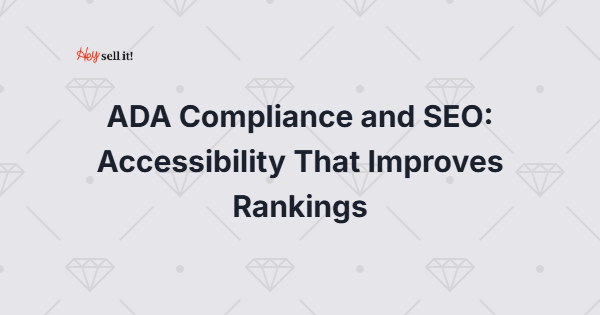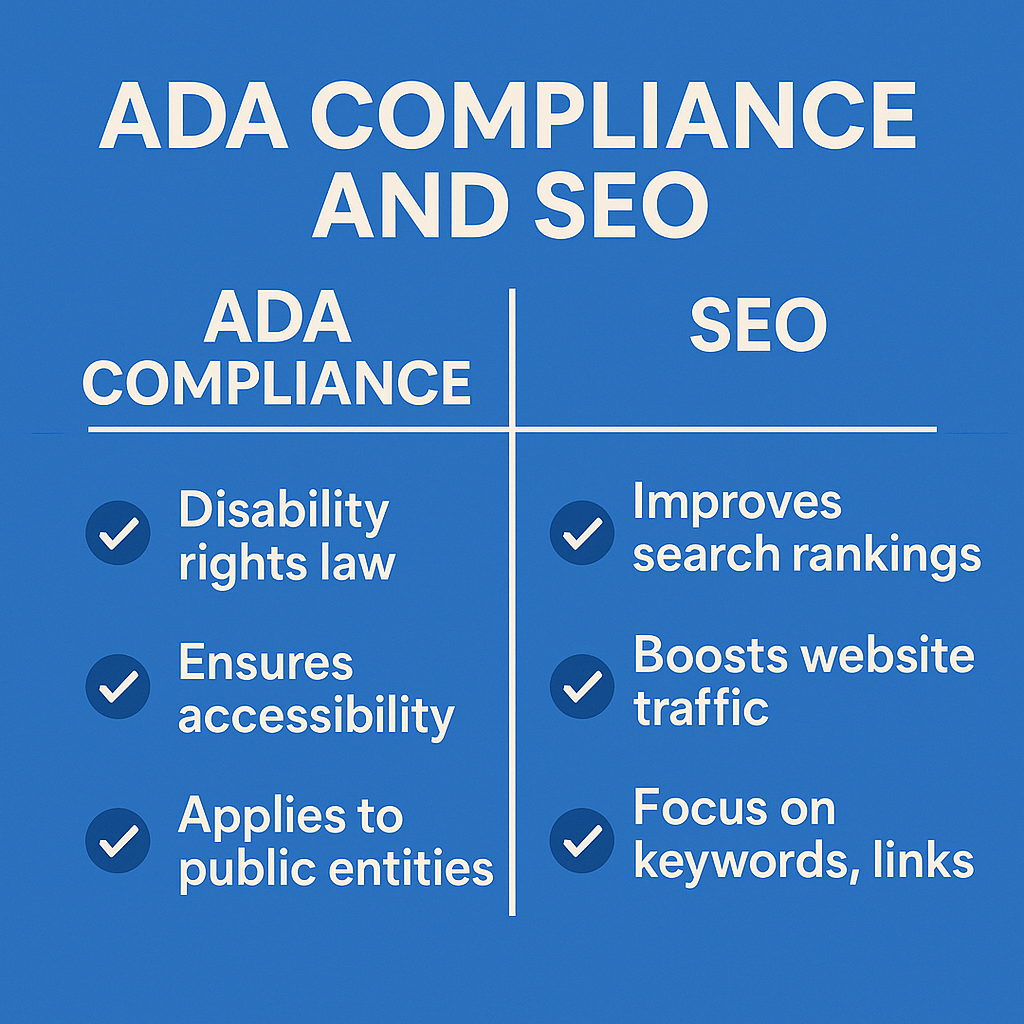Abdullah Usman
You’re losing potential customers every single day, and you don’t even know it. While you’re focused on perfecting your product pages and optimizing for keywords, 26% of American adults with disabilities can’t access your website properly. But here’s the twist – fixing this accessibility gap doesn’t just open doors to millions of potential customers; it actually boosts your search engine rankings too.
As someone who’s spent eight years helping businesses climb Google’s rankings through comprehensive SEO services, I’ve seen firsthand how ADA compliance creates a win-win scenario that most business owners completely overlook. Today, we’re diving deep into why accessibility isn’t just the right thing to do – it’s one of the smartest SEO strategies you’re not using yet.
What Exactly Is ADA Compliance and Why Should Your Business Care?
The Americans with Disabilities Act (ADA) requires businesses to provide equal access to people with disabilities, and yes, this includes your website. While the legal landscape is still evolving, over 4,000 ADA-related lawsuits were filed against businesses in 2023 alone – a 320% increase from five years ago.
But let’s talk about the opportunity side. The disability market represents $13 trillion in annual disposable income globally. When your website is accessible, you’re not just avoiding potential legal issues; you’re tapping into a massive customer base that your competitors are likely ignoring.
The Web Content Accessibility Guidelines (WCAG) 2.1 Level AA has become the gold standard for website accessibility. This isn’t just legal jargon – it’s your roadmap to creating a website that works for everyone while performing better in search results.
How Does ADA Compliance Actually Boost Your SEO Rankings?
Here’s where it gets interesting. Google’s algorithm and accessibility guidelines share the same fundamental goal: creating better user experiences. When you make your website more accessible, you’re essentially checking off multiple SEO ranking factors without even trying.
Google’s Core Web Vitals, which directly impact your search rankings, measure loading performance, interactivity, and visual stability. Accessible websites typically score higher on these metrics because they’re built with clean, semantic code and optimized user experiences. A study by WebAIM found that accessible websites load 15-20% faster on average than non-accessible sites.
The semantic SEO connection is particularly powerful. When you use proper heading structures (H1, H2, H3) for screen readers, you’re also creating a clear content hierarchy that search engines love. Alt text for images doesn’t just help visually impaired users – it gives Google context about your visual content, improving your chances of ranking in image search results.
Consider this real example: After implementing comprehensive accessibility improvements, online retailer Target saw a 10% increase in organic traffic within six months. Their clean markup, improved site navigation, and semantic HTML structure didn’t just serve users with disabilities better – it made their entire site more crawlable and understandable to search engines.
Which ADA Compliance Features Have the Biggest SEO Impact?
Let’s break down the accessibility features that pack the biggest SEO punch for your ecommerce SEO or local SEO efforts.
Semantic HTML Structure: Using proper HTML tags (header, nav, main, article, aside, footer) instead of generic div tags creates a logical page structure. This semantic markup helps search engines understand your content hierarchy and improves your on-page SEO significantly. Google’s John Mueller has specifically mentioned that semantic HTML helps with content understanding and ranking.
Descriptive Alt Text: Every image on your site should have meaningful alt text that describes the image’s content and context. This serves visually impaired users and gives search engines valuable context. Product images with detailed alt text can improve your visibility in Google Images, which drives 22% of all web searches according to recent data.
Keyboard Navigation: Ensuring your entire website can be navigated using only a keyboard improves usability for people with motor disabilities and creates cleaner, more logical site architecture. This logical navigation structure helps search engine crawlers index your pages more effectively, supporting your overall SEO audit efforts.
Color Contrast and Visual Design: WCAG requires a 4.5:1 contrast ratio between text and background colors. This isn’t just about accessibility – higher contrast improves readability for all users, potentially increasing time on page and reducing bounce rates, both important ranking factors.
What Are the Most Common ADA Compliance Mistakes That Hurt Your SEO?
Through countless SEO audits, I’ve noticed the same accessibility mistakes repeatedly tanking both user experience and search performance.
Missing or Generic Alt Text: “Image1.jpg” or “product photo” tells neither users nor search engines anything useful. Descriptive alt text like “red leather handbag with gold chain strap on white background” provides context that improves both accessibility and SEO. This mistake is particularly damaging for ecommerce SEO, where product images drive significant traffic.
Poor Heading Structure: Jumping from H1 to H3 or using headings for styling rather than structure confuses screen readers and search engines alike. Your heading structure should create a logical content outline that both users and crawlers can follow easily.
Inaccessible Forms: Forms without proper labels, error messages, or clear instructions create barriers for users with disabilities and often have poor conversion rates. Search engines also struggle to understand poorly structured forms, which can impact your local SEO efforts if you’re collecting location-based information.
Auto-playing Media: Videos or audio that start automatically can be disorienting for users with cognitive disabilities and create poor user experience signals that Google tracks. These elements also slow page load times, directly impacting your Core Web Vitals scores.
How Can Small Businesses Implement ADA Compliance Cost-Effectively?
You don’t need a massive budget to start improving accessibility and SEO simultaneously. Here’s a practical roadmap based on what I’ve seen work for small and medium-sized businesses.
Start with an Accessibility Audit: Use free tools like WAVE, aXe, or Lighthouse to identify the most critical issues. Focus on problems that affect both accessibility and SEO first – missing alt text, poor heading structure, and form accessibility issues should be your priority.
Implement Quick Wins: Adding alt text, improving heading structure, and ensuring adequate color contrast can often be done without significant technical resources. These changes provide immediate benefits for both accessibility and your on-page SEO.
Choose Accessible Themes and Plugins: If you’re using WordPress or another CMS, select themes and plugins that are built with accessibility in mind. Many modern themes include accessibility features by default, saving you time and development costs.
Create Accessible Content: Train your content team to write descriptive link text, use proper heading structures, and create captions for videos. This approach improves content quality for all users while supporting your semantic SEO efforts.
For ecommerce store owners, platforms like Shopify and WooCommerce now offer accessibility-focused themes and plugins that handle much of the technical implementation automatically.
Why Is ADA Compliance Becoming More Important for Local SEO?
Local businesses face unique accessibility challenges and opportunities. Google My Business listings, local directory submissions, and location-based content all benefit from accessibility improvements.
When your website is accessible, users spend more time engaging with your content, leave better reviews, and are more likely to visit your physical location. These engagement signals directly impact your local search rankings. A restaurant in Portland saw a 25% increase in online reservations after implementing accessibility improvements that also streamlined their mobile booking process.
Local SEO success depends heavily on user experience signals, and accessibility improvements often enhance these metrics across the board. Faster loading times, clearer navigation, and better mobile usability all support your local search visibility while serving users with disabilities.
What Tools and Resources Can Help You Get Started Today?
Free Accessibility Testing Tools:
- WAVE Web Accessibility Evaluator for quick page scans
- Google Lighthouse for comprehensive accessibility and performance audits
- aXe DevTools browser extension for detailed accessibility testing
- Color Oracle for testing color blindness accessibility
Paid Solutions for Ongoing Compliance:
- AudioEye and accessiBe offer automated accessibility solutions, though they should supplement, not replace, proper development practices
- UsableNet provides enterprise-level accessibility testing and remediation
Educational Resources:
- WebAIM’s accessibility guidelines provide practical implementation guidance
- A11y Project offers beginner-friendly accessibility tips and best practices
- Google’s Web Accessibility course covers both accessibility and SEO benefits
What Does the Future Hold for ADA Compliance and SEO?
The intersection of accessibility and SEO is only going to strengthen. Google’s upcoming algorithm updates continue emphasizing user experience, and accessibility is a fundamental component of good UX. The proposed ADA Title III regulations may soon require explicit WCAG 2.1 Level AA compliance for many businesses, making this both a legal necessity and competitive advantage.
Voice search optimization, which is crucial for modern off-page SEO strategies, relies heavily on semantic markup and clear content structure – the same elements that make websites accessible to screen readers. As voice search grows, businesses with accessible, well-structured content will have significant advantages.
Artificial intelligence and machine learning algorithms are becoming better at evaluating user experience quality, and accessibility factors are increasingly part of these assessments. The businesses that invest in accessibility now will be better positioned for future algorithm changes.
Action Steps: Your 30-Day ADA Compliance and SEO Improvement Plan
Week 1: Assessment and Quick Wins
- Run a comprehensive accessibility audit using WAVE and Lighthouse
- Add missing alt text to your most important pages and product images
- Review and fix your heading structure across key landing pages
- Check color contrast ratios and adjust where necessary
Week 2: Technical Implementation
- Ensure all forms have proper labels and error handling
- Implement keyboard navigation testing across your site
- Add skip navigation links for screen reader users
- Optimize images for both accessibility and page speed
Week 3: Content and Structure
- Review and improve link text throughout your site
- Create or update video captions and transcripts
- Implement proper ARIA labels where needed
- Test your checkout process (for ecommerce) or contact forms with accessibility tools
Week 4: Testing and Refinement
- Conduct user testing with accessibility in mind
- Review Core Web Vitals scores and accessibility improvements
- Document your accessibility improvements for ongoing compliance
- Plan for regular accessibility maintenance and updates
The reality is simple: ADA compliance isn’t just about doing the right thing anymore – it’s about doing the smart thing for your business. When you make your website accessible, you’re not just opening doors for users with disabilities; you’re creating a better experience for everyone while boosting your search engine rankings.
Ready to turn accessibility into your competitive advantage? The businesses that act now will capture market share while their competitors are still figuring out why their rankings are slipping. Your users – and your bottom line – will thank you for it.


